Analysis of Tourist Satisfaction Index Based on Structural Equation Model
Abstract
In the modern economy and society, traveling abroad has gradually become one of the ways for people to enjoy life. With the continuous development of tourism and the change of tourists’ consumption concepts, tourists’ satisfaction has been received by more and more tourism managers and operators. It pays attention to providing tourism products and services from the perspective of tourists and meets the personalized and diversified needs of tourists. Tourist satisfaction has become an important indicator to measure the level of tourism in a tourist destination. According to the structural equation model, this paper constructs the tourist satisfaction index analysis index, which can truly and efficiently detect the tourist satisfaction index, which is convenient for the scenic spot to find out the areas that need to be improved, and enhance the new attraction and service level of the scenic spot. The research results of the article show that (1) there is no significant difference in the satisfaction of tourists of different genders. In terms of influencing factor indicators, individual factors have not passed the T test. The difference in satisfaction of tourists of different ages is not obvious, but there are also individual factors that do not pass the significance test in terms of influencing factors. For the actual perceived quality, the observation index with a larger contribution rate to principal component 2 is mainly the tourists’ evaluation of the satisfaction of the tourist attractions. (2) The test result of the structural equation-based satisfaction analysis model proposed in the article is the highest among the four models. According to the error curve, it can be concluded that with the increasing complexity of the data, for the other three models, the evaluation error of the tourist satisfaction evaluation model is getting larger and larger, and the errors of the models proposed in the article are basically controlled within 0.4. Therefore, it can be concluded that the satisfaction evaluation model based on structural equations can reduce the error of tourist satisfaction.
1. Introduction
With the increasing economic development, people’s various needs have been paid more and more attention, and various leisure and tourism experiences have become increasingly diversified. Satisfaction has also become an important reference indicator to measure the competitiveness and development of a tourist attraction. This paper studies the tourist satisfaction of Daegu city tourism and proposes a structural equation model [1]. This article attempts to analyze the relationship between tourist satisfaction and loyalty in tourist destinations [2]. The purpose of the article is to provide two examples of advanced analysis, including a new nonlinear latent variable method to measure hygiene and pleasure factors in visitor satisfaction monitoring and the application of inferred causal theory to explore the antecedents of satisfaction [3]. Based on the American Customer Satisfaction Index model, this paper constructs a structural equation model of tourist satisfaction from four aspects: tourist experience, tourist perceived value, tourist satisfaction, and tourist loyalty [4]. Based on the American Customer Satisfaction Index, this paper takes AMOS (Analysis of Moment Structure) and SPSS statistical software as examples to test the validity and practicability of the TSRTD (Tourist Satisfaction of Rural Tourism Destination) model [5]. The article proposes a framework of “experience value (functional value, situational value, emotional value, cognitive value, economic value), satisfaction and post-travel revisit and recommendation willingness” to investigate Kangyang Mountain tourism [6]. This paper proposes a tourist satisfaction model of a destination and takes Guilin as a case to study the causes and consequences of tourist satisfaction [7]. The research hypothesis of the article includes five main factors that lead to tourist loyalty, as well as some potential variables: corporate social responsibility, destination image, perceived value, tourist satisfaction, and tourist complaints [8]. This paper analyzes a specific wine tourism segment in the global context of tourism consumer behavior by examining the perceptions of winery tourists [9]. The article analyzes the data using structural equation modeling, draws theoretical and managerial implications based on the findings, and makes recommendations for future researchers [10]. This study is aimed at exploring the predictors of place attachment and measuring the impact of place attachment and its predictors on tourist satisfaction and how this satisfaction affects tourists’ future revisiting [11]. In this paper, the method of exploratory factor analysis and structural equation model is used to propose a satisfaction model of urban forest tourists [12]. Based on structural equation modeling, this paper explores the relationship between travel satisfaction and destination loyalty intentions [13]. This paper uses AMOS software combined with structural equation model to explore the causal relationship of tourist satisfaction and obtains the relationship between various influencing factors and the direct and indirect effects between influencing factors and tourist satisfaction [14]. This paper builds a hypothesis model on the basis of previous research literature, collects data through on-site questionnaires, and establishes a structural equation model for hypothesis testing [15]. In the tourism market, there are obvious differences between different genders in tourism satisfaction. There are great differences in the evaluation of satisfaction of different customer groups by analyzing the different characteristics of tourists from different dimensions of data. The structural equation evaluation method proposed in this paper has objective fairness and has better performance in satisfaction evaluation compared with other methods.
2. Construction of Indicators and Model Structure
2.1. Satisfaction Index Model
The American Customer Satisfaction Index model is based on summarizing the Swedish Customer Satisfaction Index model and uses three observation variables: customerization quality, reliability quality, and overall quality to measure the latent variable perceived quality, and a new latent variable is added: perception value, as shown in Figure 1:

2.2. Construction of the Indicator System
At present, most of the construction of the tourist satisfaction evaluation system is based on the theory of customer satisfaction. In order to meet the needs of national mass tourism and improve the quality of tourism services, the China Tourism Academy has constructed a tourist satisfaction survey and evaluation covering all elements of tourism [16]. The construction of tourist satisfaction index system is shown in Tables 1 and 2:
| Latent variable | Measure variable | Latent variable | Measure variable |
|---|---|---|---|
| City tourism image |
|
Perceived value |
|
| Tourist expectations |
|
Tourist satisfaction |
|
| Perceived quality |
|
|
|
| Measure variable | Evaluation index [17] | Measured variables [18] | Evaluation index [19] |
|---|---|---|---|
| Construction and management |
|
Public service |
|
| Public service |
|
Tourism features |
|
3. Structural Equation Model Analysis of Tourist Satisfaction Indicators
3.1. Structural Model
Among them, η = (n1, n2, ⋯, nn) is the vector composed of intrinsic latent variables, ξ = (ξ1, ξ2, ⋯, ξn) is the vector composed of extrinsic latent variables, B(m × m) is the path coefficient matrix of intrinsic latent variables, Γ(m × n) is the path coefficient matrix of exogenous latent variables, and τ(m × 1) is the vector composed of residual terms, reflecting the unexplained part of η in the equation.
Among them, is the arithmetic mean of customer satisfaction latent variable , is the lowest score of customer satisfaction latent variable , and is the highest score of customer satisfaction latent variable .
3.2. Analysis of Tourist Satisfaction Index
4. Simulation Experiments
4.1. Data Collection
The experiment conducted an empirical analysis on the satisfaction of tourists with different attributes and the satisfaction of the influencing factors. The attributes of tourists are compared according to gender and age. The data source is from the tourist satisfaction data provided by a provincial tourism bureau in the second quarter of 2010. For the degree survey data, the experiment was conducted in the form of a questionnaire survey. 300 questionnaires were distributed to the public, and 270 valid questionnaires were issued. The survey locations covered 2 5A-level scenic spots and some 4A-level scenic spots in the province. According to the results of the questionnaire survey, it can be found that there are more female tourists than males, accounting for 58%. From the perspective of age, the number of tourists in the 25-54 age group is the largest, accounting for 60% of the respondents. In terms of education level, the number of tourists with a bachelor’s degree is the largest, accounting for 43.21% of the total number. Descriptive statistical analysis was carried out on the sample data, and the specific data are shown in Table 3.
| Measurement standard | Sample size | Minimum | Maximum value | Numerical value | Standard error | Skewness |
|---|---|---|---|---|---|---|
| Tourism image | 300 | 3 | 10 | 7.56 | 0.093 | -0.420 |
| Overall service level | 300 | 3 | 10 | 7.74 | 0.094 | -0.325 |
| Overall expectations of tourism quality | 300 | 4 | 10 | 6.37 | 0.125 | -0.103 |
| Expectation of service quality in tourism process | 300 | 4 | 10 | 6.19 | 0.132 | -0.126 |
| Overall quality | 300 | 2 | 10 | 6.39 | 0.104 | 0.134 |
| Hardware facilities | 300 | 2 | 10 | 6.34 | 0.138 | 0.110 |
| Software facilities | 300 | 2 | 10 | 6.42 | 0.145 | -0.043 |
| Reasonable price | 300 | 4 | 10 | 7.28 | 0.098 | -0.678 |
| Overall cost performance | 300 | 3 | 10 | 6.79 | 0.107 | -0.457 |
| Satisfaction level | 300 | 3 | 10 | 7.54 | 0.098 | -0.836 |
| Satisfaction compared to needs | 300 | 3 | 10 | 7.26 | 0.104 | -0.657 |
| Satisfaction compared to ideal | 300 | 3 | 10 | 7.33 | 0.097 | -0.802 |
| Possibility to travel again | 300 | 3 | 10 | 7.53 | 0.117 | -0.892 |
| Possibility to recommend others to travel | 300 | 3 | 10 | 7.18 | 0.123 | -0.595 |
According to the statistical data in Table 4 and Figure 2, it can be seen that there is no significant difference in the satisfaction of tourists of different genders. In terms of influencing factor indicators, individual factors did not pass the T test and the variety of commodities, the taste of catering, the environment of catering, and the abundance of entertainment activities. There are clear differences in sex. In terms of the variety of commodities and the richness of entertainment activities, especially in terms of commodity types, women’s satisfaction is significantly higher than that of men, and in terms of food and beverage indicators, in terms of the taste and environment of food and beverages, men are significantly more satisfied than women (high degree).
| Measurement standard | Satisfaction | Influencing factors | Satisfaction | Male satisfaction | Female satisfaction | P value |
|---|---|---|---|---|---|---|
| Scenic spot | 7.14 | Landscape | 7.25 | 7.27 | 7.24 | 0.168 |
| Appreciate the value | 7.22 | 7.15 | 7.25 | 0.135 | ||
| Environment | 7.10 | 7.20 | 7.10 | 0.129 | ||
| Toll | 7.02 | 7.00 | 6.89 | 0.131 | ||
| Entertainment | 7.06 | Full facilities | 7.01 | 7.02 | 6.97 | 0.161 |
| Rich in activities | 7.05 | 7.04 | 7.07 | 0.035 | ||
| Special | 7.12 | 7.10 | 7.14 | 0.153 | ||
| Stay | 6.82 | Health | 6.80 | 6.73 | 6.82 | 0.137 |
| Comfortable | 6.93 | 6.87 | 6.96 | 0.133 | ||
| Price | 6.70 | 6.85 | 6.68 | 1.112 | ||
| Shopping | 6.70 | Product category | 6.66 | 6.49 | 6.75 | 0.001 |
| Commodity price | 6.60 | 6.56 | 6.73 | 0.126 | ||
| Shopping | 6.81 | 6.90 | 6.79 | 0.094 | ||
| Travel | 6.54 | Convenient | 6.53 | 6.52 | 6.54 | 0.206 |
| Full facilities | 6.55 | 6.57 | 6.53 | 0.150 | ||
| Food | 6.52 | Taste | 6.40 | 6.71 | 6.13 | 0.004 |
| Environment | 6.50 | 6.66 | 6.38 | 0.015 | ||
| Feature | 6.69 | 6.74 | 6.56 | 0.068 |
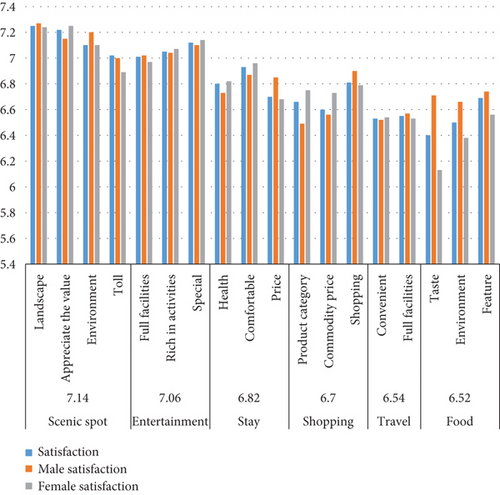
According to the statistical results in Table 5 and Figure 3, from the perspective of age, the 25-54 age group has the largest number of tourists, accounting for 59% of the surveyed, 14-24 years old accounted for 27%, and over 55 years old accounted for 14%. It can be seen that the tourists in the scenic spot are mainly young and middle-aged. The difference in satisfaction of tourists of different ages is not obvious, but in terms of the influencing factor indicators, there are also individual factors that have not passed the significance test. In terms of commodity types and catering tastes, especially in terms of commodity types, the satisfaction of the 15-24-year-old age group is significantly higher than that of other age groups; and in the commodity price index, the 15-24-year-old age group is significantly more satisfied. The satisfaction of the age group over 55 is significantly lower than that of the age group of 25-54. In terms of travel convenience, the satisfaction of the age group of 25-54 is relatively high.
| Measurement standard | Satisfaction | Influencing factors | Satisfaction | 15-24 | 25-54 | Over 55 | P value |
|---|---|---|---|---|---|---|---|
| Scenic spot | 7.14 | Landscape | 7.25 | 7.40 | 7.21 | 7.30 | 0.057 |
| Appreciate the value | 7.22 | 7.20 | 7.23 | 7.21 | 0.145 | ||
| Environment | 7.10 | 7.16 | 7.11 | 7.07 | 0.125 | ||
| Toll | 7.02 | 7.24 | 6.92 | 7.16 | 0.131 | ||
| Entertainment | 7.06 | Full facilities | 7.01 | 6.88 | 7.03 | 7.01 | 0.234 |
| Rich in activities | 7.05 | 7.02 | 7.07 | 7.10 | 0.143 | ||
| Special | 7.12 | 7.07 | 7.13 | 7.15 | 0.156 | ||
| Stay | 6.82 | Health | 6.80 | 6.91 | 6.76 | 6.75 | 0.065 |
| Comfortable | 6.93 | 7.06 | 6.91 | 6.96 | 0.124 | ||
| Price | 6.70 | 6.79 | 6.65 | 6.62 | 0.059 | ||
| Shopping | 6.70 | Product category | 6.66 | 6.81 | 6.58 | 6.59 | 0.012 |
| Commodity price | 6.60 | 6.51 | 6.67 | 6.49 | 0.023 | ||
| Shopping | 6.81 | 6.89 | 6.79 | 6.80 | 0.164 | ||
| Travel | 6.54 | Convenient | 6.53 | 6.52 | 6.69 | 6.48 | 0.000 |
| Full facilities | 6.55 | 6.67 | 6.54 | 6.72 | 0.068 | ||
| Food | 6.52 | Taste | 6.40 | 6.62 | 6.35 | 6.48 | 0.004 |
| Environment | 6.50 | 6.61 | 6.48 | 6.69 | 0.072 | ||
| Feature | 6.69 | 6.71 | 6.67 | 6.64 | 0.054 |
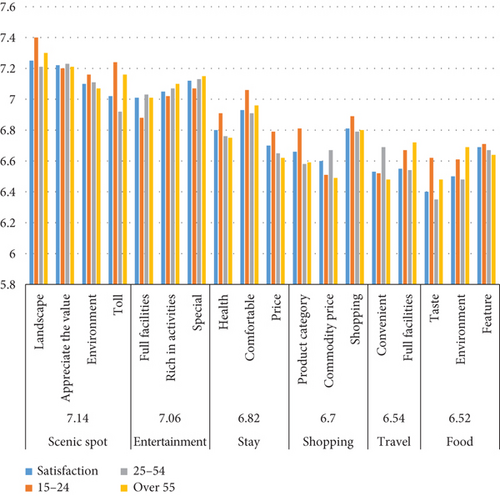
4.2. Data Analysis
According to the contribution rate that affects the satisfaction of tourists, 13 evaluation indicators are selected for investigation and research on tourists’ expectations of the scenic spot, perception of the scenic spot infrastructure, and scenic spot characteristics. Since there is information overlap and correlation between the evaluation indicators, the principal component analysis method is used to analyze and study them. The research results are shown in Table 6.
| Evaluation variable | Principal component 1 | Principal component 2 | Total |
|---|---|---|---|
| Natural environment expectations | 0.855 | 0.06 | 0.915 |
| Social service expectations | 0.761 | 0.001 | 0.763 |
| Landscape features | 0.582 | 0.351 | 0.933 |
| Scenic traffic | 0.623 | 0.293 | 0.916 |
| Sanitation | 0.906 | 0.003 | 0.910 |
| Scenic capacity | 0.901 | 0.028 | 0.929 |
| Viewing facilities | 0.832 | 0.095 | 0.927 |
| Scenic spot commodity prices | 0.718 | 0.199 | 0.917 |
| Scenic spot ticket evaluation | 0.683 | 0.274 | 0.957 |
| Ideal scenic spot evaluation | 0.687 | 0.281 | 0.967 |
| General impression | 0.765 | 0.097 | 0.862 |
| Complaint | 0.711 | 0.212 | 0.923 |
| Revisit | 0.676 | 0.275 | 0.951 |
According to the experimental results in Table 6 and Figure 4, we can conclude that the contribution rate of principal component 1 is 74.621, the contribution rate of principal component is 16.688, the cumulative contribution rate is 91.309, and the amount of information loss is only 9.691, which meets the requirements of principal component analysis for the amount of information loss. It shows that the selection of two principal components can basically reflect the evaluation of tourists’ satisfaction. The evaluation indicators with the largest contribution rate to the principal component 1 are the capacity of the scenic spot (0.90 1), the hygiene of the scenic spot (0.906), the viewing facilities of the scenic spot (0.832), the expectation of the natural environment of the scenic spot (0.855), the overall evaluation of the scenic spot (0.765), the society of the scenic spot, and service expectation (0.761); the largest contribution rate to principal component 2 is the scenic landscape feature (0.351), the scenic traffic (0.293), the scenic ideal evaluation (0.281), the revisiting (0.275), the scenic spot ticket evaluation (0.27 4), the Scenic area complaints (0.212), and scenic spot commodity prices (0.199). Among them, the observation indicators with a larger contribution rate to principal component 1 are mainly tourists’ expectations and actual perceived quality of tourist attractions, and the observation indicators with a larger contribution rate to principal component 2 are mainly tourists’ evaluation of tourist attractions. The structural variables can be simplified as tourists’ perceived quality and tourists’ satisfaction. The observed variables that characterize the perceived quality of tourists are the scenic capacity of the scenic spot, the hygiene of the scenic spot, the viewing facilities of the scenic spot, the expectation of the natural environment of the scenic spot, the expectation of the social service of the scenic spot, and the scenic spot. For the overall impression, the observational variable indicators that characterize the structural variables of tourist satisfaction are scenic landscape features, scenic traffic, scenic ideal evaluation, revisiting, scenic ticket evaluation, complaints about scenic spots, and scenic spot commodity prices. According to the analysis of the evaluation indicators affecting tourist satisfaction, the revision of the tourist satisfaction evaluation model is shown in Table 7.
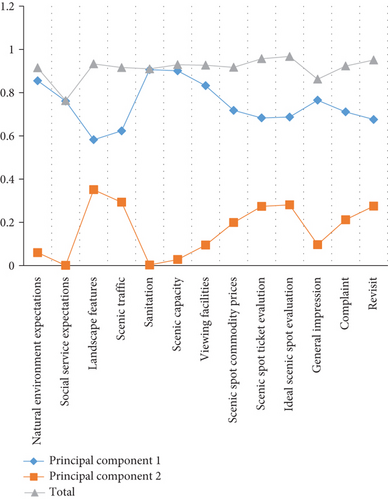
| Evaluation variable | Tourist satisfaction | Tourist perceived quality | Satisfaction |
|---|---|---|---|
| Natural environment expectations | 74.25 | 0.150 | 0.121 |
| Social service expectations | 67.50 | 0.075 | 0.060 |
| Landscape features | 73.75 | 0.071 | 0.057 |
| Scenic traffic | 59.75 | 0.058 | 0.046 |
| Sanitation | 69.75 | 0.119 | 0.096 |
| Scenic capacity | 66.50 | 0.176 | 0.141 |
| Viewing facilities | 59.00 | 0.102 | 0.082 |
| Scenic spot commodity prices | 67.75 | 0.075 | 0.061 |
| Scenic spot ticket evaluation | 81.00 | 0.063 | 0.051 |
| Ideal scenic spot evaluation | 82.00 | 0.067 | 0.054 |
| General impression | 77.25 | 0.059 | 0.048 |
| Complaint | 68.00 | 0.075 | 0.060 |
| Revisit | 46.50 | 0.028 | 0.023 |
According to the experimental data in Table 7 and Figure 5, we can conclude that among the structural variables, the perceived quality of tourists has a strong positive correlation with the satisfaction of tourists, and the path coefficient is 0.805. In the relationship between structural variables and observed variables, in terms of the perceived quality of tourists, each observed variable has a strong impact on it. Taking the expected load coefficient on the natural environment as the standard 1, the load coefficient of the viewing facilities (1.091) has a greater impact on it. The impact of natural environment expectations is stronger, and the relative natural environment expectations such as scenic environmental capacity (0.897), scenic traffic (0.869), scenic overall impressions, and landscape characteristics (0.821) are relatively weak. In terms of tourist satisfaction, revisiting (1.303), scenic spot ticket price (1.153), and scenic spot ideal evaluation (1.177) all have more influence on it than the scenic spot commodity price (1.000).
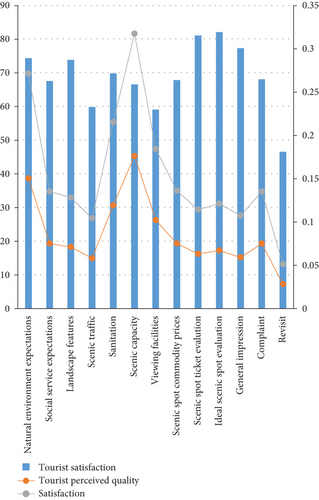
4.3. Model Comparison
In order to verify the performance of the tourist satisfaction analysis model based on the structural equation model, the experiment compares the proposed model with the other three models to test the superiority of the model performance. In the experiment, after running 4 different models on the experimental set, observe the experimental results of the 4 models. Among them, the experimental set is a set of samples set aside separately during the model training process, which can be used to adjust the hyperparameters of the model and to perform a preliminary evaluation of the ability of the model. The experiment also recorded the satisfaction evaluation error comparison curves of the four models. The steps to record the satisfaction evaluation error comparison curves are to first use the tourist satisfaction evaluation model of data mining technology to randomly generate the evaluation data format and then to randomly generate the tourist satisfaction. The evaluation is processed, the tourist satisfaction evaluation coefficient and the comprehensive evaluation vector are calculated, and the complexity of the tourist satisfaction evaluation data is used as an independent variable to analyze and count the evaluation error value. The specific experimental data are as follows in Figures 6 and 7.
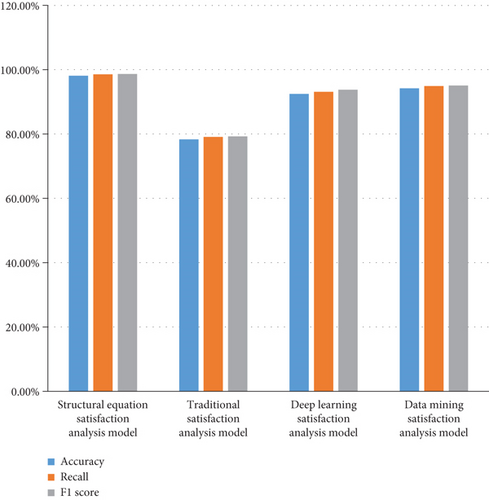
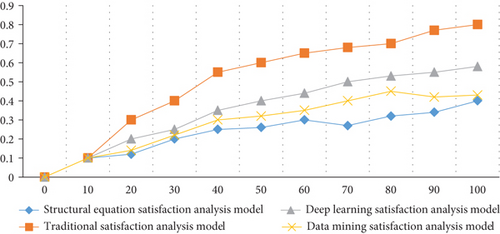
According to the experimental data in Tables 8 and 9, the test result of the satisfaction analysis model based on structural equation proposed in this article is the highest among the four models, with an accuracy rate of 98.12%, a recall rate of 98.56%, and an F1 value. The test result of the traditional satisfaction analysis model is the lowest among the four models. The experimental results also show that the performance of the structural equation satisfaction analysis model is the best. According to the evaluation error tables of the four models, we can conclude that when the complexity of the tourist satisfaction evaluation data is less than 30%, the evaluation errors of the four tourist satisfaction evaluation models are all less than 0.3 points, but with the complexity of the data, the degree is getting higher and higher, and the evaluation errors of the other three models of tourist satisfaction evaluation models are getting larger and larger. When the complexity of the tourist satisfaction evaluation data reaches 100%, the evaluation error reaches a maximum of 0.8 points and the model proposed in the article. The error is basically controlled within 0.4, so it can be concluded that the satisfaction evaluation model based on structural equation can reduce the error of tourist satisfaction.
| Model | Accuracy | Recall | F1 score |
|---|---|---|---|
| Structural equation satisfaction analysis model | 98.12% | 98.56% | 98.69% |
| Traditional satisfaction analysis model | 78.32% | 79.10% | 79.23% |
| Deep learning satisfaction analysis model | 92.45% | 93.14% | 93.79% |
| Data mining satisfaction analysis model | 94.21% | 94.89% | 95.10% |
| Structural equation satisfaction analysis model | Traditional satisfaction analysis model | Deep learning satisfaction analysis model | Data mining satisfaction analysis model | |
|---|---|---|---|---|
| 0 | 0 | 0 | 0 | 0 |
| 10 | 0.1 | 0.1 | 0.1 | 0.1 |
| 20 | 0.12 | 0.3 | 0.2 | 0.14 |
| 30 | 0.2 | 0.4 | 0.25 | 0.22 |
| 40 | 0.25 | 0.55 | 0.35 | 0.3 |
| 50 | 0.26 | 0.6 | 0.4 | 0.32 |
| 60 | 0.3 | 0.65 | 0.44 | 0.35 |
| 70 | 0.27 | 0.68 | 0.5 | 0.4 |
| 80 | 0.32 | 0.7 | 0.53 | 0.45 |
| 90 | 0.34 | 0.77 | 0.55 | 0.42 |
| 100 | 0.4 | 0.8 | 0.58 | 0.43 |
5. Conclusion
Under the background of the fast pace of life, traveling abroad has gradually become one of the ways for people to relax and enjoy life. In the process of traveling, tourists also evaluate the work level of tourists, the quality of classic tourism resources, and tourism perception experience. It is an important reference indicator for the competitiveness and development level of tourist destinations. This paper takes the analysis of tourist satisfaction index as the research object and uses structural equation model to analyze the relationship between the influencing factors of tourist satisfaction and the degree of influence, which can accurately and efficiently analyze the value of tourist satisfaction index. There are also some shortcomings in the analysis process of the article. For example, the results of the questionnaire survey have regional limitations. The article only conducts a questionnaire survey on tourists’ satisfaction within a certain province. The conclusion of the empirical analysis has obvious characteristics of hell. In the research work, it is possible to have an in-depth understanding of the personal factors, tourism motivation, and consumption behavior of tourists.
Conflicts of Interest
The authors declared that they have no conflicts of interest regarding this work.
Open Research
Data Availability
The experimental data used to support the findings of this study are available from the corresponding author upon request.




